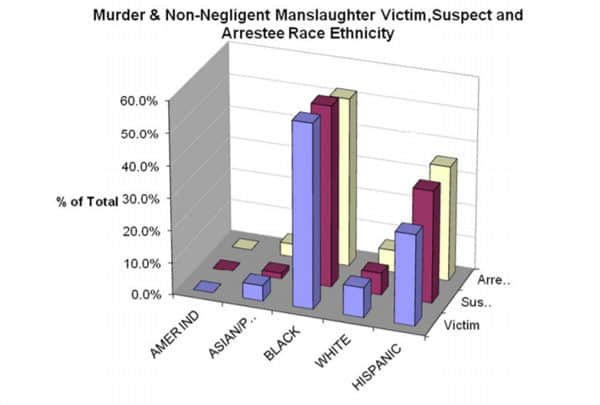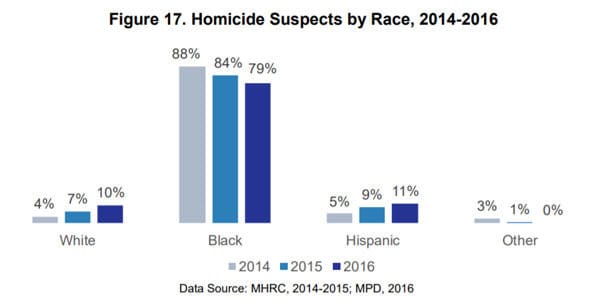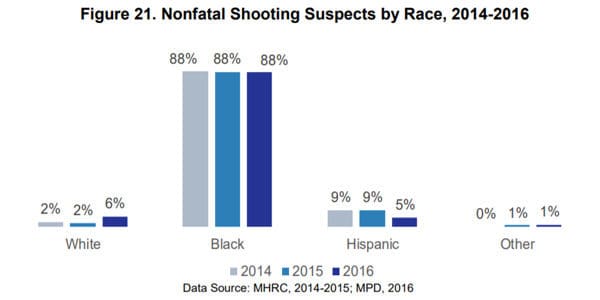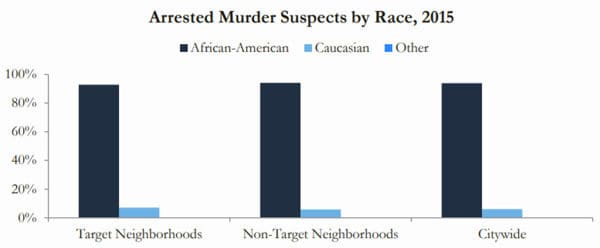The Color of Gun Crime in America’s Big Cities
Paul Kersey, American Renaissance, April 10, 2018
This is the animus that underlies the left’s position on gun control. It has nothing to do with reducing “gun violence” and everything to do with dis-empowering and punishing a group of people that they hate, hate, hate. pic.twitter.com/Hi9nS0qJXd
— J Burton (@JBurtonXP) April 4, 2018
The Second Amendment is under siege. In the New York Times, retired Supreme Court justice John Paul Stevens urged its repeal. A national survey conducted by The Economist and YouGov found 21 percent of Americans support repealing the Second Amendment. Not surprisingly, support varies greatly by race and party affiliation, with 39 percent of Democrats, 30 percent of blacks, and 27 percent of Hispanics in favor of repeal. Only eight percent of Republicans and 19 percent of whites feel the same.
Signs at the “March For Our Lives” rally showed many protesters were not motivated by concerns about public safety, but by rage against gun owners, who were often conflated with “evil white men” generally and deemed the equivalent of terrorists.
For example, some slogans at the rally were:
“White Men with Guns Are America’s Biggest Terrorists”
“I Wish Obama Had Taken Your Guns”
“NRA is a Terrorist Organization”
GQ columnist Damon Young, who is also the editor-in-chief of Very Smart Brothas and an upcoming author with publisher Harper Collins, bluntly declared on February 26: “America Doesn’t Have a Gun Control Problem. We Have a White-People Problem.”
He wrote:
In America, white people are everywhere, and this ubiquity connects to perhaps our greatest irony: We (black people) are vastly outnumbered by them. . . . Our entire existence here is a continual assault on our bodies. But we are the ones perceived to be the threats. We are the ones they’re scared of. We are the ones who tell our children how to dress and how to wear their hair so they’re not thought of as threats to them. We are the ones who consciously and subconsciously modify our voices and our behavior when forced to interact with them. We’re the ones whom trained officers with weapons and badges and handcuffs and legal justifications are so damn scared of that we’ve created entire curricula based on that fear, teaching ourselves what to do to seem less frightening to them.
Portraying American gun culture as an outgrowth of white racial paranoia is a common tactic for those who want to undermine the Second Amendment. Michael Moore portrayed all of American history this way in Bowling for Columbine. Scientific American even joined the act, when one Jeremey Adam Smith explained white men are “stockpiling guns” due to existential crises.
He wrote:
These are men who are anxious about their ability to protect their families, insecure about their place in the job market, and beset by racial fears. They tend to be less educated. For the most part, they don’t appear to be religious — and, suggests one study, faith seems to reduce their attachment to guns. In fact, stockpiling guns seems to be a symptom of a much deeper crisis in meaning and purpose in their lives. Taken together, these studies describe a population that is struggling to find a new story — one in which they are once again the heroes.
Yet while journalists, celebrities, and activists delight in attacking white male gun owners as fearful and racist, the reality of gun crime in the United States is far different than the caricature presented. According to statistics from major cities around the country, the color of gun crime, like the color of crime in general, is disproportionately non-white.
New York City
The 2016 “Crime and Enforcement Activity in New York City” report from the New York City Police Department uses an estimate from the American Community Survey to provide a racial breakdown of the city for 2015. It says the city is 32.1 percent white, 29.1 percent Hispanic, and 22 percent black.
Despite being only about 22 percent of the city’s population, the report found blacks comprised a majority — 52.4 percent — of murder and non-negligent manslaughter arrests. Hispanics also exceeded their population share, accounting for 35.9 percent of arrests for these crimes. Despite being almost a third of the city’s population, white suspects accounted for less than seven percent of the share. The report noted the arrest population for these offenses “is similarly distributed.”

Source: “Crime and Enforcement Activity in New York City, 2016”
What about gun crime specifically? The report states that blacks made up a staggering 67.5 percent of shooting arrests. Hispanics accounted for 29.2 percent of arrests. The figures for whites was 2.3 percent of arrests.
This means that in 2016, 88.3 percent of those arrested for murder or non-negligent manslaughter and 96.7 percent of those arrested for shootings were black or Hispanic. The data in the 2015 edition of “Crime and Enforcement Activity in New York City” are almost identical. All this in a city where whites comprise about a third of the population.
Assuming arrest data are a good measure, whites in New York City are almost wholly innocent of murders, non-negligent manslaughters, and shootings.
Philadelphia
The United States Census estimated the 2016 population of Philadelphia to be 44.2 percent black, 34.9 percent white, and 14.4 percent Hispanic.
According to the “2015 Murder/Shooting Analysis” from the Philadelphia Police Department, there were 280 murders in Philadelphia in 2015, with 236 committed with firearms. Interestingly, even though one of the main goals of the current gun control movement is to renew the ban on so-called “assault weapons,” only three of these homicides were linked to a rifle or a shotgun; the vast majority were committed with handguns.
In the Philadelphia report, offenders are classified as black, white, Asian, or Amerindian. There is a separate figure which indicates how many offenders were of “Hispanic ethnicity,” but it’s impossible for the reader to determine how many were lumped in with each race.
At the time the report was published, 50.7 percent of the 2015 murder cases were “cleared,” usually meaning a suspect was taken into custody.
From the 133 cases so designated, 105 offenders are identified in the report. Eighty-six (81.9 percent of the total) were black, 18 (17.1 percent) were white, and one (one percent) was Asian. Of this group of 105, ten were of “Hispanic ethnicity.” Given a choice between “black” and “white,” Hispanics are almost always classified as “white,” so possibly all ten of the Hispanic murderers were included in the “white” figure. If that’s the case, whites may comprise only 7.6 percent of identified homicide offenders.
In 2015, there were 1,236 non-fatal shooting victims, but only 238 offenders were identified. Blacks were 85.7 percent of them, whites were 13 percent, and Amerindians were 1.3 percent. Almost 11 percent were Hispanic. If these Hispanics were categorized as “white,” then whites may have been offenders in as little as two percent of these non-fatal shootings.
Milwaukee
According to the 2010 census, Milwaukee is 40 percent black, 37 percent white, and 17.3 percent Hispanic.
The 2016 Annual Report on “Homicides and Nonfatal Shootings in Milwaukee” from the Milwaukee Homicide Review Commission states there were 139 homicides and 555 non-fatal shooting victims in the city in 2016.
Suspects were not identified in all of these cases, but of those that were, the commission found that 79 percent of homicide suspects in 2016 were black, 11 percent were Hispanic, and 10 percent were white. For non-fatal shootings, 88 percent of suspects were black, 6 percent were white, and five percent were Hispanic.


Thus blacks and Hispanics, who comprise 57 percent of the city, account for over 90 percent of suspects in homicide and non-fatal shooting cases.
Pittsburgh
According to the 2010 Census, Pittsburgh has a population which is 64.8 percent white, 26.1 percent black, and 2.3 percent Hispanic. As the 2016 Annual Report from the Police Department states: “Black men were the most likely to be both the actors and the victims of homicide in the city of Pittsburgh last year.”
A gun was used in 86.2 percent of the total 58 homicides in the city. The report states “90.62% of all [known homicide] actors were black men.”
The same was true in 2015, when 81.8 percent of all homicide suspects were black men. The vast majority of homicides that year — 89.3 percent — were committed using a gun.
Los Angeles
According to the American Community Survey 2016 estimates, Los Angeles is 49 percent Hispanic, 29 percent white, 8 percent black, and 11 percent Asian.
The findings of the “Los Angeles Police Department Homicide Report” for 2017 are unsurprising for racial realists. According to this analysis, both the victims and perpetrators of violent crime in Los Angels are young, non-white, and poor. Of the 282 homicides which occurred in Los Angeles in 2017, 177 — 62.8 percent — were gang related.
Of all homicides committed in 2017 in Los Angeles, 72 percent involved handguns. Shotguns and rifles accounted for only one percent each. “Assault weapons” — the weapons targeted by current gun control push — accounted only for one percent. Firearms were used in 93 percent of homicides committed by gang members.
Suspect descriptions were provided for 146 of the homicides, yielding 171 suspects (some incidents involved more than one suspect). Of these suspects, 52 percent were Hispanic, six percent were white, and less than two percent were Asian. An astonishing 40 percent were black, despite blacks comprising less than ten percent of the city’s population.

Source: “Los Angeles Police Department Homicide Report, 2017”
New Orleans
New Orleans is, as former mayor Ray Nagin famously bragged, a “chocolate city.” The city’s population, according to the 2010 census, is 60.2 percent black, 30.5 percent white, and 5.2 percent Hispanic, though the Hispanic population has been increasing in recent years. However, the color of gun crime in New Orleans is almost entirely black.
The 2015 “City of New Orleans Murders And Non-Fatal Shootings Trend” shows there were 164 murders in that year and 340 non-fatal shooting victims. The report indicates 87 percent of those arrested for murder were black males. If females are included, over 90 percent of those arrested for murder were black.

Source: “City of New Orleans Murders And Non-Fatal Shootings Trend, 2015”
An almost identical pattern emerged with non-fatal shootings. Eighty-six percent of those arrested were black men. Again, rather than “assault weapons” or rifles being the weapons of choice, handguns were used 78 percent of the time.
Chicago
According to the 2010 census, Chicago is 32 percent black, 31.7 percent white, and 28 percent Hispanic.
The Chicago Police Department put out an Annual Report every year until 2010. In 2016, the Chicago Tribune reported the department would be releasing reports again, but no such report has been issued.
According to the 2010 report, 248 arrests were made for murder or non-negligent manslaughter. Of those, 190 were black, 48 were Hispanic, eight were white, one was Asian, and one was Amerindian.
While the report contains no data on non-fatal shootings, weapons violations — crimes such as unlawful concealment of a firearm–showed the same pattern. Of the 3,903 arrests for that crime, 3,011 were black, 722 were Hispanic, 152 were white, and 15 were Asian.
Blacks and Hispanics therefore accounted for 96 percent of murder and non-negligent manslaughter arrests, and 95.6 percent of weapons violation arrests.
Conclusion
The narrative that white men with guns are somehow the greatest threat to Americans is an extreme example of gaslighting. The color of gun crime in major cities around the United States is black and, to a lesser extent, brown. Banning “assault weapons” or rifles will do nothing to reduce gun crime. It will simply make it more difficult for whites to defend themselves, which may be the overall point.
Since the Parkland shooting, a number of prominent media voices and policymakers, such as former secretary of state Condoleezza Rice, have called for a “conversation” about gun violence. She is right. It is time for a real conversation about gun violence. It’s time to discuss why gun violence in so many of our major cities is overwhelmingly committed by blacks, and why so many propagandists seem utterly determined to blame whites for it instead.















